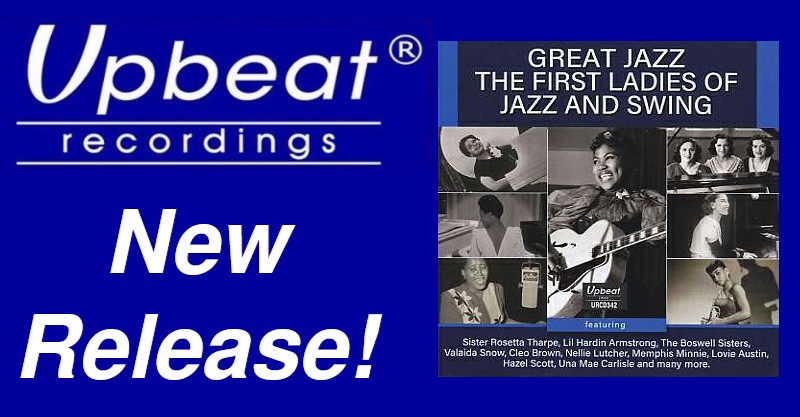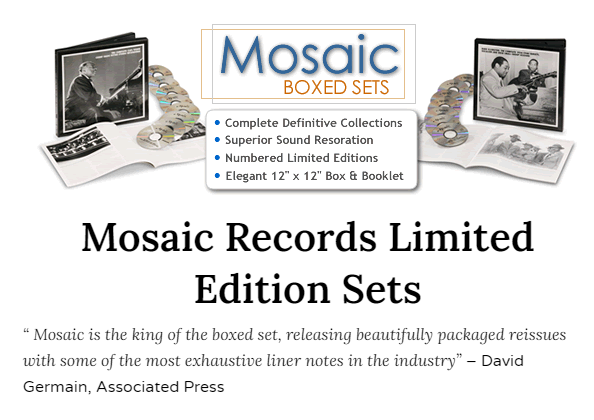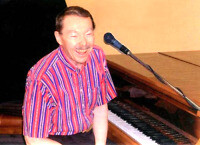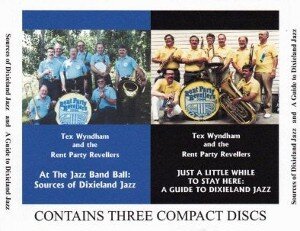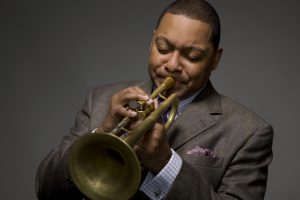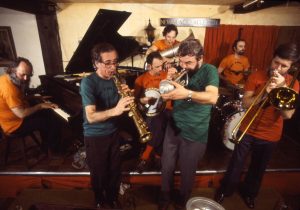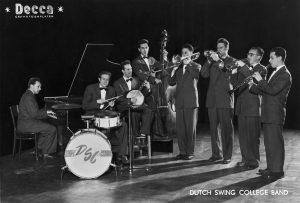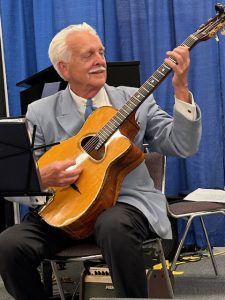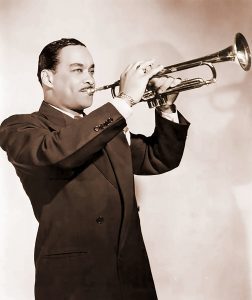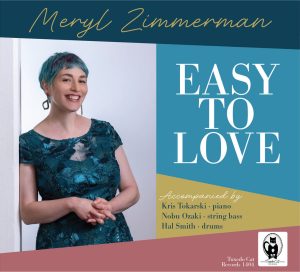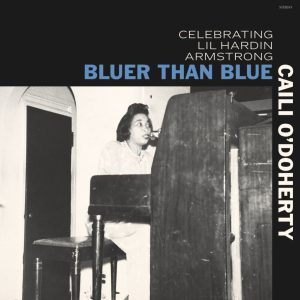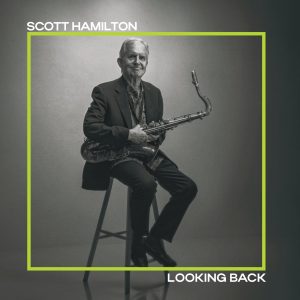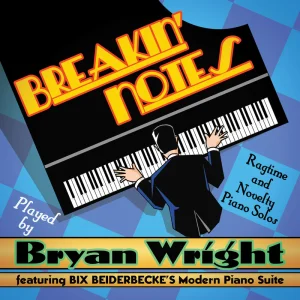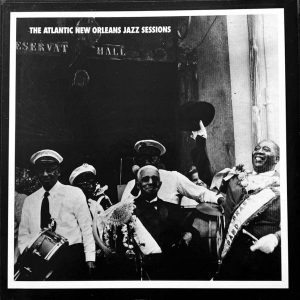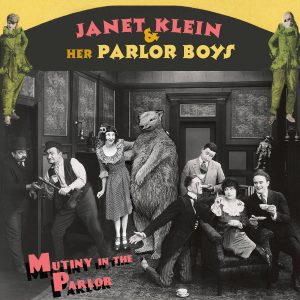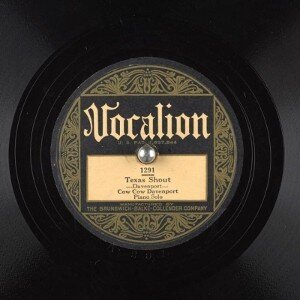 Set forth below is the twenty-seventh “Texas Shout” column. It first appeared in the April 1992 issue of the West Coast Rag, (now Syncopated Times.) It is the concluding part of a two part essay. Read: Texas Shout #26 Economics of Dixieland Part 1
Set forth below is the twenty-seventh “Texas Shout” column. It first appeared in the April 1992 issue of the West Coast Rag, (now Syncopated Times.) It is the concluding part of a two part essay. Read: Texas Shout #26 Economics of Dixieland Part 1
At any rate, whether for Blacks or whites, for festival volunteers or record producers, or anyone else, Dixieland jazz is overwhelmingly a hobby music these days. This is hardly a startling conclusion — anyone with two eyes can see that it is so — but the foregoing comments about the economics of hiring a band for a commercial club gig do place in perspective just how precarious the situation really is. Further, this situation has had a noticeable effect on both the music itself and on how it is perceived by what public it has.
In our example, we postulated hiring a sextet at $50 per musician for the evening. We can find bands that will play a regular club gig for less, sometimes for not much more than drinks, but if you tell yourself you’re playing it for pay, $50 is pretty much a going minimum.
Unfortunately, it was also pretty much a going minimum thirty years ago when I started playing Dixieland in night spots. Think about how much inflation we’ve experienced in thirty years, while the going nightly rate for Dixielanders remained in the $50-$75 range, and you’ll quickly see why professional Dixieland players are a disappearing breed.
If the older-style jazz musicians of today are mostly hobbyists, they have the benefit (not one to be treated lightly) of being able to perform reasonably free from the constraints of that dreaded word “commerciality.” However, like everything in the real world, there are both pluses and minuses in this situation.
“Practice makes perfect” is an old saw, but it is certainly true when it comes to playing music. It hardly needs to be said that the full-time professional who plays a four-hour Dixieland gig each night, and who has additional practice time available during the day, ought to be better at doing so than a hobbyist musician who plays one or two gigs a week and catches what practice time he can in the evenings.
Moreover, if you are a person who values imagination and creativity in jazz solos, you can hardly fail to notice the appreciable amount of chord-running and favorite licks that emanate from festival stages these days, even from the most prestigious events and best-known bands. You must have observed that the individual Dixielanders who most often surprise you, the ones who best blend innovative ideas with the ability to execute those ideas, are, with few exceptions, artists who make a full-time living out of music (not necessarily 100% Dixieland), or have spent an appreciable part of their careers as full-timers, or are doing so much playing that they are virtually full-timers.
Clearly, at least if you compare today’s Dixieland with records from 20-30 years ago, something has markedly changed in the soloing area. I believe that the relative dearth of professionals in the ranks is a significant factor behind that change.
Actually, the effect of hobbyism on the quality of today’s Dixieland music is a subject that deserves a column all its own. I’ll write one for you someday.
Apart from the effect of hobbyism on the music itself, I think that whenever a product becomes exempt from the commercial demands of the marketplace, when it is no longer seen as being required to pay its own way, it is in danger of losing something important. Specifically, it may lose a common basis for judging what its standards are.
For example, I see a slackening of standards with respect to what constitutes a record review worthy of publication. In the periodicals I read, there seem to be more and more reviewers who are all too willing to write a review that consists of announcing that a record has been made and then praising it to the skies in general terms.
Some of these reviews contain little or no useful information to a reader contemplating purchase of the album. Such information might include the style of Dixieland being played (I wonder if some of the current crop of reviewers are fully aware of the variety of Dixieland styles?), the instrumentation, the quality of the fidelity, and how to order a copy by mail.
Similarly, as I have previously noted in this column, the Dixieland scene is being increasingly populated, for understandable reasons, by an audience not primarily motivated by a desire to hear good Dixieland jazz. They’d really rather hear country, Latin, swing, pop or whatever.
There are some compelling non-economic factors contributing to this change. Still, if pure Dixieland were better able to pay its own way, I feel sure we’d see a much smaller proportion of non-genre music in the current Dixieland scene.
We pay serious attention to Dixieland jazz, we write articles about it, because we believe that our music is an art form, one which remains capable of creative expression, of speaking to us on a level deeper than its surface characteristics. If we are not going to try to maintain that view of the music in the face of the many pressures leading us to do otherwise, then we might as well open our Dixieland festival stages to anything that will provide a few laughs and a danceable beat; we might as well open WCR’s pages to listings for ice cream tastings and balloon ascensions.
In short, standards are important. If Dixieland is a valid art form, we ought to be able to recognize what is Dixieland and what isn’t. We ought to know how to tell good Dixieland from the not-as-good, and we should strive to seek out the best quality available within the limitations of our individual budgets, travel ranges, etc.
How can we each play a part in the effort to maintain standards and still enjoy the things about the scene that we’re enjoying now? I can think of one way, taking off from my deeply-held belief that the more you know about something, the more you’re likely to get out of it and the more fun you’re likely to have with it.
Why not take a little time to focus your thinking on just what it is you like about the music and why? Why do you prefer this band, or this clarinetist, or this vocalist, or this tune, over that one? See if you can refine your own criteria for understanding and liking Dixieland in a way that will help you locate what you believe are the better elements of it.
That’s an effort which costs you nothing and which you can make while you’re on the scene having a good time. After you’ve started along that path, then do one more thing — discuss the subject with your friends and fellow fans, and try to get them started along the same trail.
The goal here, of course, is to heighten your awareness of Dixieland as an art form, to get you to gravitate toward the better music without giving up on the things you already enjoy about it. If you want to see bands with good-looking female singers, fine, but why not learn to find the one who’s just as good-looking but a better vocalist, or who has a better band backing her up? If your real desire is to hear the bandleader tell jokes, no problem, but why not spend your time with the band that has both good jokes and good music? Let’s dance to Dixieland by all means, but why not choose the band that’s not only danceable but listenable when you decide to sit one out?
If we can try to keep the music a little more in focus, perhaps we can get our crowds moving toward the stages which not only entertain us but also are producing a higher level of artistic accomplishment. If that movement takes place, the bands left behind will be under pressure to improve their artistic content as well. Then we’ll all be better off.
Personally, while I love Dixielanders, the fans, the scene, the performing, etc., I also love this music for itself alone. I enjoy sharing the high it gives me and have tried over the years, via such things as this column, record reviews, liner notes and live presentations, to get you thinking about how the music works, what separates the best from the rest, and how to derive as much pleasure from it as I do.
In fact, in recent years, I’ve been involved in presenting three special shows on the festival circuit designed (hopefully in an entertaining way) to heighten the audience’s ability to appreciate our music. Judging from the way these shows have been received, I’d say there is a high degree of interest out there in this topic.
[These three shows are now available on CD. To read a review of two of them, see: Tex Wyndham’s Three CD Guide to Dixieland Jazz, the third is A History of Ragtime: Tex Wyndham Live At Santa Rosa. All are available directly from the Wyndhams, ordering information below.]
I don’t expect that you will all agree with my views (nor would I prefer it that way), but I would like to get everyone reading these words to think more about the subject. Some of you have told me that my activities have helped expand your jazz horizons, so I know the process works; I know you can get involved in it without too much effort and can lead others to do so.
There is also a way you can help deal with the economic problems mentioned at the start of this column. It will take a little more time and money, but the rewards justify the expenditure.
Why not decide, once you’ve started to crystallize your ideas on the type of Dixieland you prefer, that during the next year you’ll go out to hear it live just a few more times? Attendance by each of us at, say, three or four more club gigs, or jazz society meetings, or anywhere that Dixieland is played, would go a long way toward making our music more viable in the market, and it wouldn’t cost any of us all that much individually.
Nancy and I made that decision about two years ago. There are four older-style jazz societies around Wilmington, Delaware that we have long supported via membership, but none are close enough to attend conveniently. Moreover, there are no nightspots in our area regularly presenting Dixieland.
However, when we started to read, in the club publications, that attendance was dwindling at their regular presentations, we figured it was time for us to put our money where our hearts were. We picked one of the clubs and decided, though it is a two-hour drive each way, that we’d try to get to as many functions as we could.
My playing and travel schedules still keep us from making the trip more than about three times a year, but it’s been well worth the effort. We’ve met some great people, bought some fine recordings at the record bar that aren’t available in my local stores, taken advantage of the opportunity to dance (obviously not an option at my own gigs) and heard some terrific music. We got to know some musicians a little better, including the excellent banjoist Cynthia Sayer who, shortly after our jazz society conversation, became a member of The Rent Party Revellers.
Even though the current economics of Dixieland are discouraging, we can all, without sacrificing any of our pleasure, and without putting in much more time and money, do something to help insure the standards of the music are maintained and that the demands of the commercial marketplace are satisfied. For me, the alternatives are too bleak to contemplate.
Back to the Texas Shout Index.
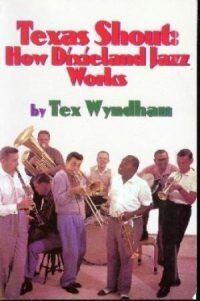
The full run of “Texas Shout” has been collected into a lavishly illustrated trade paperback entitled Texas Shout: How Dixieland Jazz Works. This book is available @ $20.00 plus $2.95 shipping from Tex Wyndham, On request, Tex will autograph the book and add a personalized note (be sure to tell him to whom the note should be addressed).
Tex Wyndham’s 3 CD Guide to Dixieland with music and commentary is available for $20 plus $2.95 shipping. The separate CD, A History of Ragtime: Tex Wyndham Live At Santa Rosa, is available for $13.00 plus $2.00 shipping. On request, Tex will autograph the inner sleeve and add a personalized note (be sure to tell him to whom the note should be addressed).
Send payment to Tex Wyndham, P.O. Box 831, Mendenhall, PA 19357, Phone (610) 388-6330.
Note: All links, pictures, videos or graphics accompanying the Shouts were added at the discretion of the Syncopated Times editorial staff. They did not accompany the original columns and do not necessarily reflect the opinion of Tex Wyndham.
From roughly 1970-2010, Tex Wyndham was: (1) one of the best-known revivalist Dixieland jazz musicians in the US, as cornetist, pianist and bandleader, (2) one of the best-known ragtime pianists in the US, and (3) one of the most respected critics in the US of Dixieland jazz, ragtime, and related music. He is the only person about whom all three of those statements can be made.


